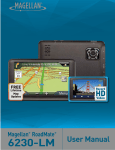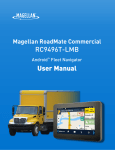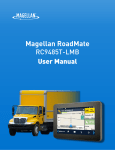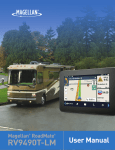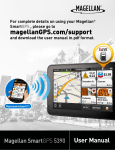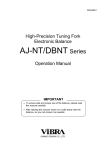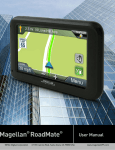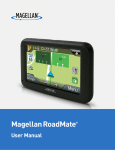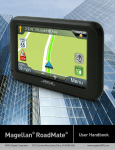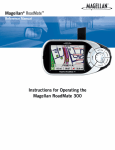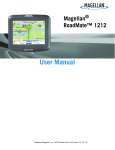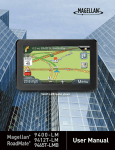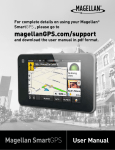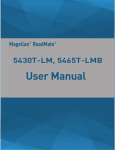Download Roadmate HD 430i User manual
Transcript
® FREE Record HD Video Lifetime Map Updates Magellan RoadMate ® 6220-LM 6230-LMX 6235-LM ® User Manual IMPORTANT SAFETY WARNINGS The Magellan RoadMate receiver is a vehicle-navigation aid designed to assist you in arriving at your selected destinations. When using the Magellan RoadMate receiver, these safety rules must be followed to prevent accidents that can result in injury or death to yourself or others: Please check the applicable regulations in your state regarding windshield mounting. Certain states prohibit the mounting of any items on your windshield. Go to www.magellanGPS.com for alternative mounting solutions. When driving, the need to view the display is minimal. Voice prompts will guide you to your destination. The driver should enter data or program the Magellan RoadMate receiver only when the vehicle is stationary. Only a vehicle passenger should enter data or program the Magellan RoadMate receiver while the vehicle is moving. Do not become distracted by the receiver while driving, and always be fully aware of all driving conditions. It is your responsibility to comply with all traffic laws and to use the Magellan RoadMate and mounting options in such a manner that the user is in compliance with applicable laws. Roads, points of interest (POIs), business and service locations may change over time. As a result the database may contain inaccuracy. Also, the database does not include, analyze, process, consider, or reflect any of the following: legal restrictions (such as vehicle type, weight, height, width, load and speed restrictions); road slope or gradient; bridge height, width, weight or other limits; population Magellan RoadMate 6220T-LM density; neighborhood quality or safety; availability or proximity of police, emergency rescue, medical or other Tested To Comply assistance; construction work zones or hazards; road With FCC Standards or lane closures; road, traffic or traffic facilities’ safety or condition; weather conditions; pavement characteristics or conditions; special events; traffic congestion. It is your FOR HOME OR OFFICE USE responsibility to disregard any unsafe, hazardous or illegal route suggestions. Keep the Magellan RoadMate receiver safe from extreme temperature conditions. For example, do not leave it exposed to direct sunlight for an extended period of time. Take care when mounting the Magellan RoadMate receiver in your vehicle, whether using the windshield mount or other mounts, that it does not obstruct the driver’s view of the road, interfere with the operation of the vehicle’s safety devices such as air bags, or present a hazard to occupants of the vehicle should the receiver be dislodged while driving. It is your responsibility to assess the risks associated with damage to your vehicle or vehicle occupants as the result of your choices in mounting the Magellan RoadMate receiver. Temperature The maximum operating temperature is 140°F (60°C). Battery The battery in the Magellan RoadMate receiver is rechargeable and should not be removed. In the event that it should need to be replaced, please contact Magellan Technical Support. Charging the Magellan RoadMate An optional AC adapter is available as an accessory for your Magellan RoadMate. Use of RoadMate User Manual Page ii another type of AC adapter can result in malfunction and/or possible fire hazard due to battery overheating. Use only the car charger approved for/supplied with your Magellan RoadMate receiver. Use of another type of car charger will result in fire or electric shock. For safety reasons, the battery in your Magellan RoadMate receiver will stop charging when the ambient temperature is less than 32°F (0°C) or more than 113°F (45°C). It will take approximately 4 hours of charging the Magellan RoadMate receiver through the vehicle power adapter or optional AC adapter to obtain a full battery charge. It is recommended that you charge the battery initially for at least 2 hours. Use only the charger approved for your Magellan RoadMate receiver. Estimated usage of the Magellan RoadMate on battery power is approximately 1 hour. Federal Communication Commission Interference Statement This equipment has been tested and found to comply with the limits for class B digital devices, in accordance with part 15 of the FCC Rules. These limits are designed to provide reasonable protection against harmful interference in a residential installation. This equipment generates, uses and can radiate radio frequency energy and, if not installed and used in accordance with the instructions, may cause harmful interference to radio communications. However, there is no guarantee that interference will not occur in a particular installation. If this equipment does cause harmful interference to radio or television reception, which can be determined by turning the equipment off and on, the user is encouraged to try to correct the interference by one of the following measures: Reorient or relocate the receiving antenna. Increase the separation between the equipment and receiver. Connect the equipment into an outlet on a circuit different from that to which the receiver is connected. Consult the dealer or an experienced radio/TV technician for help. This device complies with Part 15 of the FCC Rules. Operation is subject to the following two conditions: (1) This device may not cause harmful interference, and (2) this device must accept any interference received, including interference that may cause undesired operation. FCC Caution: Any changes or modifications not expressly approved by the party responsible for compliance could void the user’s authority to operate this equipment. IMPORTANT NOTE: FCC Radiation Exposure Statement: This equipment complies with FCC radiation exposure limits set forth for an uncontrolled environment. End users must follow the specific operating instructions for satisfying RF exposure compliance. This transmitter must not be co-located or operating in conjunction with any other antenna or transmitter. In order to maintain compliance with FCC regulations, shielded cables must be used with this equipment. Operation with non-approved equipment or unshielded cables is likely to result in interference to radio and TV reception. The user is cautioned that changes and modifications RoadMate User Manual Page iii made to the equipment without the approval of manufacturer could void the user’s authority to operate this equipment. The Magellan RoadMate receiver must be installed and operated at a distance no closer than 8 inches (20 cm) from the user. This Class B digital apparatus meets all requirements of the Canadian Interference-Causing Equipment Regulations. IC statement Operation is subject to the following two conditions: 1. This device may not cause interference and 2. This device must accept any interference, including interference that may cause undesired operation of the device. IMPORTANT NOTE: IC Radiation Exposure Statement: This equipment complies with IC radiation exposure limits established for an uncontrolled environment. End users must follow the specific operating instructions for satisfying RF exposure compliance. This transmitter must not be co-located or operated in conjunction with any other antenna or transmitter. One or more claims of the following patents may cover this product: U.S. patent No. 5,544,060, U.S. patent No. 5,654,892, U.S. patent No. 5,832,408 and U.S. patent No. 5,987,375 The information provided in this document is subject to change without notice. Improvements and enhancements to the product may occur without any formal notification. Check the Magellan website (www.magellanGPS.com/support) for product updates and additional information. © 2014 MiTAC International Corporation. The Magellan logo, Magellan, RoadMate and Quickspell are registered trademarks of MiTAC International Corporation. SmartDetour and OneTouch are trademarks of MiTAC International Corporation and are used under license by MiTAC International Corporation. All rights reserved. All other products and brand names are trademarks of their respective holders. No part of this user manual may be reproduced or transmitted in any form or by any means, electronic or mechanical, including photocopying and recording, for any purpose other than the purchaser’s personal use, without the prior written permission of MiTAC International Corporation. The information provided in this document is correct at the time that it is created. MiTAC International Corporation assumes no responsibility or liability for any errors or inaccuracies that may appear in the contents of this User Manual. 112-0079-001 RoadMate User Manual Page iv Contents IMPORTANT SAFETY WARNINGS..............................................................ii 1 Magellan RoadMate GPS Receiver with DVR.........................................1 Magellan RoadMate controls and features................................................................ 2 Reset...............................................................................................................................................2 2 Fundamentals...........................................................................................3 Battery Levels................................................................................................................... 3 Viewing the Battery Level Indicator....................................................................................3 Speaker Volume.............................................................................................................. 3 Changing the Volume from the Map Screen...................................................................3 Changing the Volume from Settings...................................................................................3 Setting Button Sounds On or Off.........................................................................................3 Setting Smart Volume On or Off...........................................................................................3 Brightness......................................................................................................................... 4 Accessing the Brightness Control.........................................................................................4 Main Menu....................................................................................................................... 4 Accessing the Main Menu.....................................................................................................4 Keypad.............................................................................................................................. 5 Selecting From List.....................................................................................................................5 Selecting QWERTY or ABC keyboard..................................................................................5 Notes on entering data.................................................................................................. 5 QuickSpell......................................................................................................................... 5 Smart City Search............................................................................................................ 6 3 Map Screen...............................................................................................7 Normal Mode Map Screen......................................................................................................7 Routing Mode Map Screen.....................................................................................................7 Setting Map Options.................................................................................................................8 Selecting Map Mode and Default Zoom Level ................................................................8 Panning on the Map.................................................................................................................9 Routing to a Panned Position................................................................................................9 Current Location Screen................................................................................................ 9 Accessing the Current Location Screen..............................................................................9 Saving Your Current Location to Your Address Book....................................................9 Maneuver List (Itinerary).............................................................................................10 Accessing the Maneuver List............................................................................................... 10 Avoiding a Maneuver............................................................................................................ 10 RoadMate User Manual Page v Changing Route Options..................................................................................................... 10 Volume............................................................................................................................10 Changing the Volume from the Map Screen................................................................ 10 4 OneTouch Menu.................................................................................... 11 Accessing the OneTouch Menu........................................................................................ 11 The Home Button..........................................................................................................11 Saving an Address to a OneTouch Icon.......................................................................... 11 Changing the Address or Search of a OneTouch Icon.............................................. 11 Saving a POI Search Criteria to a OneTouch Icon........................................................ 12 Setting a Route to a OneTouch Icon................................................................................ 12 5 Selecting a Destination......................................................................... 13 Creating a Destination to an Address.............................................................................. 13 Tips on Entering Addresses Quickly..........................................................................14 Intersections...................................................................................................................14 Creating a Destination to an Intersection....................................................................... 14 City Centers....................................................................................................................15 Creating a Destination to a City Center........................................................................... 15 Previous Destinations...................................................................................................15 Routing to a Previous Destination..................................................................................... 15 Clearing the list of Previous Destinations........................................................................ 15 Address Book.................................................................................................................15 Saving a Destination to Your Address Book................................................................... 15 Accessing an Address in Your Address Book................................................................ 16 Routing to an Address in Your Address Book............................................................... 16 6 Traveling on a Route............................................................................ 17 Map Screen.....................................................................................................................17 Maneuver List................................................................................................................17 Accessing the Maneuver List............................................................................................... 17 Viewing a Maneuver............................................................................................................. 17 Excluding a Maneuver.......................................................................................................... 17 Types of Routes.............................................................................................................17 Changing the Routing Method.......................................................................................... 18 Compare Routing Methods................................................................................................. 18 To Change the Default Routing Method ....................................................................... 18 Special Routing Functions...........................................................................................18 Cancelling a Route................................................................................................................. 18 RoadMate User Manual Page vi Detouring off a Route........................................................................................................... 18 7 Points of Interest (POI)......................................................................... 20 Creating a Route to a POI by Category........................................................................... 20 Creating a Route to a POI by Name................................................................................. 21 Creating a Route to a Highway Exit POI......................................................................... 21 8 Using the DVR....................................................................................... 22 DVR Screen and Controls............................................................................................22 Storage and locked Recordings..................................................................................22 DVR Settings..................................................................................................................22 Automatic Recording...................................................................................................23 Viewing Recordings on the Device...........................................................................23 Viewing Recordings on a Computer.........................................................................23 Using your receiver as a card reader................................................................................ 23 Using your computer’s card reader ................................................................................. 23 Locate and run the player program................................................................................. 23 Magellan Player.............................................................................................................24 Player controls......................................................................................................................... 24 Playing recordings.................................................................................................................. 25 Locked Recordings................................................................................................................. 25 Damaged Recordings............................................................................................................ 25 Language Selection.............................................................................................................. 25 Saving recorded video.......................................................................................................... 26 Managing memory cards..................................................................................................... 26 9 Settings.................................................................................................. 27 Accessing System Settings................................................................................................... 27 Map Options..................................................................................................................27 Setting Auto Night Map Display........................................................................................ 27 Setting Heading Up or North Up in 2D Mode.............................................................. 27 Assigning Visible POIs........................................................................................................... 27 Setting Auto Zoom on Turns.............................................................................................. 27 Setting Highway Lane Assist............................................................................................... 27 Sound..............................................................................................................................28 Setting Volume from Settings............................................................................................. 28 Turning Button Sounds On/Off......................................................................................... 28 Turning Smart Volume On/Off.......................................................................................... 28 Navigation......................................................................................................................28 RoadMate User Manual Page vii Setting The Default Route Method................................................................................... 28 Setting The Turn Warning Alert Sounds......................................................................... 28 Enabling Landmark Guidance............................................................................................ 28 Enabling Spoken Street Names.......................................................................................... 28 Enabling U Turn Guidance.................................................................................................. 28 Avoiding Toll Roads............................................................................................................... 28 Avoiding Unpaved Roads.................................................................................................... 29 Brightness.......................................................................................................................29 Setting Brightness................................................................................................................... 29 Languages......................................................................................................................29 Setting Languages.................................................................................................................. 29 Speed Warnings............................................................................................................29 Setting Speed Warning Options........................................................................................ 29 Phantom Alerts........................................................................................................................ 29 Time Zone.......................................................................................................................29 Selecting the Time Zone....................................................................................................... 29 Time Format...................................................................................................................29 Setting the Time Format....................................................................................................... 29 Keyboard........................................................................................................................30 Setting the Keyboard Layout.............................................................................................. 30 Units of Measure...........................................................................................................30 Selecting Units of Measure.................................................................................................. 30 Regions...........................................................................................................................30 GPS...................................................................................................................................30 Setting the GPS Position....................................................................................................... 30 Viewing the GPS Status........................................................................................................ 30 Default System Settings...............................................................................................30 Restoring All Default System Settings............................................................................... 30 Product Information.....................................................................................................30 Viewing Product Information............................................................................................. 30 RoadMate User Manual Page viii 1 Magellan RoadMate GPS Receiver with DVR The Magellan® RoadMate® receiver is a vehicle navigation product with Digital Video Recorder (DVR) functionality. It uses GPS signals from satellites to calculate your precise location and compute navigational information. The DVR records continuous video, audio, location, and other information. The video provides an impartial witness in case of need. The RoadMate uses its position and movement to overlay this information on detailed maps to provide a visual representation of your location. With the Magellan RoadMate receiver you can: •Save searches and addresses under the OneTouch™ menu for fast, convenient access to favorite destinations and searches. •Store your home address and quickly get routing details to your home. •Save location information to create a map later of the places you went. •Save all or part of the video for later viewing. •Customize your Magellan RoadMate receiver to meet your needs using the Settings menu. The user interface for the Magellan RoadMate receiver is intended to be easy and simple to follow. The Magellan RoadMate receiver has a builtin battery so, in most cases, you will be able to follow these instructions while reading them on your computer screen without plugging the Magellan RoadMate receiver to an external power source. Note that a fully charged Magellan RoadMate only has about 60 minutes of battery life. If you need or wish to use external power, you can use an optional AC power adapter. •Route to an address that you enter using the QuickSpell™ and Smart City search for easy, errorless address entry. While the Magellan RoadMate has a powerful GPS chipset, you may not get strong enough satellite signals to compute your location when indoors or in a parking garage. If you find you are not getting strong enough satellite signals while in a garage or other structure, move to a location where there is a clear view of the sky and you should immediately see an improvement in signal strength. •Route to any point of interest (POI) that has been preloaded into your Magellan RoadMate receiver. The Magellan RoadMate receiver includes Voice Alerts (both prerecorded and Text-toSpeech) for driving instructions. •Create a route with multiple destinations. Handy for business people who need routing information to many destinations. We hope that you find this manual useful and the instructions easy to follow. •Enter and save addresses in your address book that can be accessed at any time and get routing information to that address. •View POIs that are near exits ahead of you on the highway. The Highway Exit POIs function provides you with a list of gas stations, restaurants, hotels and auto repair shops located near exits you are approaching while travelling on the interstate. RoadMate User Manual Page 1 Magellan RoadMate controls and features C A B D E F Magellan RoadMate 6220-LM, 6230-LMX, 6235-LM A Power button Press and hold to turn the device on or to completely shut down. Press momentarily to suspend or resume the device. B C D E DVR Lock button Locks current video segment to prevent overwriting. MicroSD Card for DVR Required for DVR function: MicroSD card provided with unit*** Audio Out Connect external headphones. MicroSD Card slot Available for use as external card reader for DVR playback on a PC. F USB Connector Connect to power source* or personal computer** Reset The reset button is located on the back of the receiver in the upper right corner. If you have problems with your receiver or in the unlikely event that it locks up, use a paperclip and gently insert it into the reset hole to press the reset button with the receiver turned on. The receiver should restart with the factory defaults loaded. * Power input from vehicle power adapter cable or optional AC power adapter. ** Connect your receiver to a personal computer to playback or save DVR videos, and to update maps and software using the Magellan Content Manager application. *** Size may vary by model for 6220-LM, 6230-LMX and 6235-LM. RoadMate User Manual Page 2 2 Fundamentals Battery Levels The Magellan RoadMate receiver has an internal battery that is charging whenever the receiver is connected to external power. 3. Tap . Changing the Volume from Settings 1. Access the Main Menu. 2. Tap the Settings icon. 3. Tap Sound. Note: The battery can only be serviced by authorized Magellan repair facilities. Viewing the Battery Level Indicator 1. While viewing the Map screen, tap on the Menu button in the right corner. 2. The battery level indicator is located in the upper right corner of the Main Menu, just below the satellite signal indicator. Green bars indicate battery level. Speaker Volume Changing the Volume from the Map Screen 1. Tap the speaker icon . Additional controls appear. 4. Tap the top or bottom of the Master volume adjust bar or drag the slider button to change the volume level of the Magellan RoadMate receiver. 5. Tap to save and return to the Settings screen. Setting Button Sounds On or Off 1. Access the Main Menu. 2. Tap the Settings icon. 3. Tap Sound. 4. Tap the check box for Button Sounds. Check to have button sounds played, unchecked to turn them off. Setting Smart Volume On or Off Smart Volume is a feature of the receiver that changes the volume automatically as your speed changes, compensating for road noise. 1. Access the Main Menu. 2. Tap the Settings icon. 3. Tap Sound. 4. Tap the check box for Smart Volume. When checked, Smart Volume is on. 2. Tap the speaker button to mute the volume, or tap the ‘+’ or ‘-’ buttons to raise or lower the volume. RoadMate User Manual Page 3 Brightness Accessing the Brightness Control 1. Access the Main Menu. 2. Tap the Settings icon . 3. Tap Brightness. 4. Tap the ends of the brightness adjust bar or drag the slider to set the desired brightness. Note: On the Brightness Setting screen there is a “Dim on Battery Power” option. When checked, the Magellan RoadMate receiver will reduce the brightness when operating exclusively on battery power and you have not used the touch screen for a few seconds. This prolongs the battery life between charges. Accessing the Main Menu 1. From the Map screen tap Menu. Functions Available from the Main Menu Address Enter an address as a destination for you route. Points of Interest Select a Point of Interest (POI) from the list of preloaded locations as a destination. Previous List of the most recent destinations that you have gone to before allowing you to quickly select one to route to again. Intersection Create a route to the intersection of two streets. City Center Create a route to the geographical center of a city. Current Location Displays information about your position including the street name, names of streets forward and behind you as well as the Lat/Long information for your position. Coordinates Allows direct input of Latitude and Longitude to create a route. Back Access the Map screen. Address Book Access the Address Book where you can save addresses and destinations to have available when needed. DVR Displays the DVR screen. Settings Displays the Settings menu. Lets you customize the Magellan RoadMate receiver to your personal needs. Satellite Status Graphic display of the strength of satellite signals being received. Battery Level Graphic display of the current battery level. Main Menu The Main Menu screen is the center for all available functions of the Magellan RoadMate receiver. The Main Menu contains large, easy to access icons for all the major functions. RoadMate User Manual Page 4 Keypad Accept The keypad is the most common method for entering data into the Magellan RoadMate receiver. Understanding the keypad while entering an address is an important part of using your Magellan RoadMate receiver. (Entering City) Accepts the suggested city that is displayed in the data field. (Entering street) Brings up a list of streets beginning with the characters entered. Selecting From List When a list of items found in the database are displayed, use the arrows on the right to move the list up and down and tap on the desired item in the list to continue. Selecting QWERTY or ABC keyboard 1. Access the Main Menu. 2. Tap the Settings icon . 3. Tap Keyboard. 4. Select QWERTY or ABC. Keypad overview Backspace Moves the cursor one position backwards, deletes the preceding character. Shift Shifts between uppercase and lowercase characters. Space Inserts a space at the cursor position. Numeric Displays a numeric keypad. Symbols Displays available symbols. Previous Zip Code List Previous destination list (Enter City only) When entering a city, the previous destinations list displays a list of cities previously entered. Tap on a city from the displayed list to accept that city. (Enter City only) Displays a numeric keypad to quickly enter a city when the zip code is known. (Enter City only) While entering a city, press the List button to bring up a list of cities beginning with the characters you have entered. RoadMate User Manual Notes on entering data If you are having trouble getting the results you expected, here are a few useful tips. •Check for apostrophes and hyphens. If you do not see the POI or street name you are looking for in the list, check to see if the name has an apostrophe or hyphen. •The more characters you enter, the smaller the list of possible options is from which to choose. •When entering a street or city name it is not necessary to use accented letters. You can enter city and streets names using only standard characters. QuickSpell Another feature the Magellan RoadMate receiver uses to make entering cities and streets easier, is a feature known as QuickSpell. As letters are entered for a city or street the Quickspell feature checks the database for cities or streets that begin with the letters entered. Any letters that could not be used to spell a city or street name are greyed out. This provides quick and error-free city and street name entry. Page 5 Smart City Search The Magellan RoadMate receiver utilizes a feature known as “Smart City Search”. Smart City Search attempts to predict the city you are looking for. This prediction is based upon two factors; your position and cities you have gone to before. Whenever entering or searching on an address the first screen displayed is the Enter City Name keyboard. Quickspell and Smart City Search makes entering an address quick and easy with little chance for errors. As letters are entered, Quickspell checks the database for cities beginning with the letters entered. Keys that don’t spell a city in the database are greyed out and Smart City Search displays a suggested city in the text field. If the city is correct, tap the continue. button to button can be tapped to display The the list of cities that begin with the letters entered. RoadMate User Manual Page 6 3 Map Screen The most commonly used screen is the Map screen. Whether you are following a route or just traveling around a city, the chances are that the Map screen will be displayed. The Map screen can be displayed in two unique modes: normal and routing. Normal Mode Map Screen F E D C (A) Current location. (B) Information display. Displays your choice of speed, time of day, elevation, compass direction. Tap on the information field to change. (C) Zoom Out/In. (D) Access Main Menu. (E) Access Highway POIs (Displayed only while on an Interstate, freeway, and some) state highways.) (F) Access volume controls. (G) Access OneTouch Menu. OneTouch Menu gives you instant access to your saved search criteria and favorite destinations. RoadMate User Manual I A C G B In routing mode additional information is displayed providing detailed information about the route you have selected. B In normal mode, your position is shown on the map along with the time. As you travel, your position will be updated, giving you a clear view of your position and surrounding streets. A Routing Mode Map Screen D H G F E (A) Turn instructions for next maneuver. Tap icon to display the maneuver list (available only when routing). Distance and road name for the next maneuver. Tap to repeat last voice instruction. (B) Following maneuver indicator. (C) Speed limit. (D) Information display. Displays speed, time of day, elevation, compass direction. While routing it also can also display distance to destination, estimated time of arrival (ETA), and time remaining. Tap on the information field to change. (E) Zoom in and zoom out controls to change the map scale. (F) Access Main Menu. (G) Access the list of nearest Highway Exit POIs (available only when driving on a highway/freeway/interstate). (H) Access volume, brightness controls. (I) Access OneTouch Menu for instant access to your saved search criteria and favorite destinations. Page 7 Setting Map Options The map display can be customized in Settings to your preferences. 1. From the Map screen, tap the MENU button. 2. Tap the Settings Icon. 3. Tap Map button. 4. Use the Map Options screen to customize what is shown on the map and how the map is displayed. Selecting Map Mode and Default Zoom Level When driving, the map displays at a zoom level you set here. 1. From the Map screen, tap anywhere on the map. A button appears in the lower left corner; it displays the mode it will select when tapped. 2. Tap the button to switch between 2D and 3D. The 2D mode (North Up or Heading Up) is from the settings screen as described above. 3. Tap the ‘+’ or ‘-’ zoom level buttons at the bottom of the Map screen to zoom to your preferred level, 4. Tap . Note that zoom levels are limited in 3D mode. As you zoom out in 3D, the display will switch to 2D at higher zoom levels. Night Mode For additional details on Settings, see “Settings” on page 27 Night Mode determines when (or if) the display switches from daytime mode to night mode. The button displays the active setting tap to see the options and select the one you like. There may be a brief delay before the selected mode becomes active. Map Mode (2D or 3D) Sets how the map is normally displayed: 3D - Perspective view 2D - Top down view, Heading Up 2DN - Top down view, North Up Tap the button to switch between modes. The selected mode is shown on the button. POI Visibility You can set which POIs are displayed on the map as you drive. Set checkmarks for each item you want displayed. Auto Zoom on Turns Check to enable, uncheck to disable. Highway Lane Assist Check to enable, uncheck to disable. RoadMate User Manual Page 8 Panning on the Map 1. While viewing the Map screen, slide your finger across the map. 2. The map screen changes to Pan mode. 5. Tap the large GO button on the right to begin navigating and return to the Map screen. Note: If the panned position does not match an existing street address (i.e. the destination is not along a road or street that is stored in the map database), the guidance will stop on the road that is closest to your destination. A dashed line to your final destination will then be displayed on the map. Current Location Screen 3. When finished, tap and the map returns to your current position. The Current Location screen displays the approximate address of your current position, the next and previous intersections, your latitude, longitude, heading and elevation. Routing to a Panned Position 1. Pan the map until the location you wish to route to is displayed. 2. Tap on the map at the point you want to go to. A red push pin will be displayed along with information about the point chosen at the top of the screen. Accessing the Current Location Screen 1. From the Map screen tap on the current position icon. Saving Your Current Location to Your Address Book 3. Tap the GO button in the top left corner. 4. If an active route already exists, you will need to define what to do with this new route point: Replace Destination: the next destination is cleared and replaced with the one selected from the Pan screen. Go There Now: the selected location is inserted in the route as an intermediate destination before the next destination. Add To Trip: the selected destination is added to the end of the current trip. RoadMate User Manual 1. From the Map screen tap on the current position icon . 2. Tap Save. 3. Edit information: (Optional) If you want to save this location to the OneTouch menu as well as the address book, check the Add to OneTouch box. 4. Tap the Name field and use the keypad to enter a name for the Address Book entry. (Optional) Tap List Categories to select a category for this address. New categories can be added from the Select Category Page 9 from List screen by tapping the +Add button. 5. When the details for this address are . acceptable, tap 6. If you have selected to save this point to the OneTouch menu, you need to select a button for the entry. Maneuver List (Itinerary) This screen is accessed from the Map screen and is available only when routing. Each line in the Maneuver List provides details about the maneuvers in the order that they are to be made, with the next maneuver at the top. Accessing the Maneuver List 1. When actively on a route, tap the maneuver icon in the top left corner of the Map screen. 2. Tap on Route Options. 3. The four types of routes are displayed with the computed time. A indicates that the route will use a toll road. 4. Tap on the desired route option. 5. The GO screen is displayed. Tap GO to begin routing. Volume The volume can be adjusted or muted from the Map screen. (The volume can also be adjusted from Settings > Sound.) Changing the Volume from the Map Screen 1. Tap the speaker icon. Additional controls appear. 2. Tap on the Speaker button to mute the volume, or tap the ‘+’ or ‘-’ icons to change the volume levels. Avoiding a Maneuver This is used to modify the route to possibly avoid routing on a particular street. 1. Access the Maneuver List. 2. Tap the Avoid icon you want to avoid. 1. Access the Maneuver List. for the maneuver 3. Tap Yes to confirm. 3. Tap . When muted the speaker icon on the Map screen will appear with a red diagonal line through it. Tap on the speaker icon again to unmute the volume. 4. The Magellan RoadMate receiver recalculates the route and the Map screen is displayed. Changing Route Options The options for how a route is computed can be changed to Fastest Time, Shortest Distance, Mostly Freeways, Least Use of Freeways. RoadMate User Manual Page 10 4 OneTouch Menu The OneTouch™ menu provides quick access to your home address, emergency services, gas stations and addresses or searches you have stored to the OneTouch menu. Note: If you need to edit or delete the Home address you selected here you can do this by going to the Address Book (found in the Main menu) and edit the entry labeled “Home”. Accessing the OneTouch Menu Saving an Address to a OneTouch Icon 1. From the Map screen, tap the OneTouch icon in the upper right corner. 1. Tap the Edit button in the top right corner of the Map screen. The OneTouch menu appears. 2. Tap one of the Assign icons. 3. Tap Location. 4. Using the keypad, enter the address (city, street and number) for the OneTouch icon. 5. When the address is complete you are prompted to enter a name for the button. 6. Using the keypad, enter a name for the button and tap . The Home Button Tap the Home icon. If you have a Home Address saved, the receiver will begin giving you navigation information to arrive at your home. If you do not have a Home Address saved, you will be prompted to enter one. 7. Verify that the address has been added by going to the Map screen and accessing the OneTouch menu. Changing the Address or Search of a OneTouch Icon 1. Tap the Edit button in the top right corner of the Map screen. The OneTouch menu appears. 2. Tap the Edit button. 3. Tap on the OneTouch button you want to edit. 4. Tap on the Re-assign button. 5. Tap Yes to confirm. 6. Follow the instructions for assigning a OneTouch button. If you select Yes, you will need to enter your home address using the Enter Address keyboard. To use your current location for Home, just press the Use My Current Location button. RoadMate User Manual Page 11 Saving a POI Search Criteria to a OneTouch Icon Besides frequently visited destinations, you can also save POI search criteria to a OneTouch button. For example you may frequently search for coffee shops near your location or gas stations along your route. You can save these searches for later use. 1. Tap the OneTouch button in the top right corner of the Map screen. 2. Tap one of the Assign buttons. 3. Tap Search. 4. Tap one of the POI categories in the list. Setting a Route to a OneTouch Icon With the OneTouch menu set up you can now go to a saved address or search. 1. Tap the OneTouch button in the top right corner of the Map screen. 2. Tap one of the assigned OneTouch buttons. 3. If the assigned button is for a search, the list of POIs is displayed. Tap on the desired POI. The “Preview” icon at the bottom of the display allows you to step through the available POIs while viewing their location on the map. 4. The “Near...” button allows you to select how the list is sorted (nearest your current position, nearest a city you define or near an address you enter). 5. Whether the destination was chosen from a list of POIs or by an address, the GO screen is displayed Tap on the Go button to begin the route. 5. If the next screen contains a list of subcategories, tap one of the POI subcategories in the list to further narrow the search, or tap “All Subcategories” to select all the subcategories or continue defining your search criteria. 6. Using the keypad, enter a name for the button and tap . RoadMate User Manual Page 12 5 Selecting a Destination Creating a Destination to an Address 2. Enter Street name: When creating an address, the first step is to enter the city. The city can be specified by entering the name of the city, entering the ZIP code for the city or by selecting a previously used city. 1. From the Main Menu tap the Address icon. Enter City: With the city selected, the keyboard will be displayed, prompting you for the street name. You have three ways to do this: To select the city from the list of previous cities, tap the Previous button. To enter a new city: use the keyboard to enter the first few characters of any significant word in the city name. If the city you are entering appears in the top field you can tap on the city name or . Use the keyboard to enter the street name. It is not necessary to enter accented characters. Enter the first few characters of any significant word in the street name and tap or continue entering characters until the list of streets is displayed. 3. Tap on the street name from the list. 4. Enter Street number: At any time, you can tap on the List button to bring up a list of cities that begin with the characters you entered. Tap to select the city from the list. To enter a ZIP code: if needed, tap the Zip Code button to switch to the numeric keyboard. Enter the ZIP code. Tap to bring up a list of cities with the zip code entered. RoadMate User Manual Use the keyboard to enter the street number for the address. The range of acceptable street numbers is displayed before you start typing. Tap when the street number is complete. Page 13 5. The GO screen appears with the address of the selected location, the estimated time of arrival (ETA), the distance to travel, and the routing method (e.g. Fastest Time). Intersections Creating a Destination to an Intersection When the street number is not known, an intersecting street can pinpoint the location. 1. From the Main Menu, tap the Intersection icon. 2. Enter City: You have three ways to do this: To select the city from the list of previous cities, tap the Previous button. To enter a new city: use the keyboard to enter the first few characters of any significant word in the city name. If the city you are entering appears in the top . field you can tap on the city name or (Optional) Tap Options if you want to change the routing method. (Optional) Tap on route. At any time, you can tap on the List button to bring up a list of cities that begin with the characters you entered. Tap to select the city from the list. to preview the 6. Tap the large GO button on the right to return to the Map screen and begin routing. To enter a ZIP code: if needed, tap the Zip Code button to switch to the numeric keyboard. Enter the ZIP code. Tap to bring up a list of cities with the zip code entered. Tip: If you know that you will use a destination later, before tapping the orange button you can tap Save to save it in your Address Book or in the OneTouch menu. 3. Enter Street name: With the city selected, the keyboard will be displayed prompting you for the street name. Tips on Entering Addresses Quickly •When you are entering the name of a city or a street, Magellan software only displays those characters that appear in possible search results. The other characters are grayed out. •When entering city names or street names, tap the List button after a couple of letters; Magellan software lists the items that contain the specified characters. •You can also search by ZIP codes. This narrows the number of matching cities to normally less then four. Use the keyboard to enter the street name. It is not necessary to enter accented characters. Enter the first few characters of any significant word in the street name and tap or continue entering characters until the list of streets is displayed. Tap on the street name from the list. 4. Enter the second street: Enter the name of the second street as you did the first street. 5. A screen appears with the address of the selected location, the estimated time of arrival (ETA), the distance to travel, and the routing method (e.g. Fastest Time). RoadMate User Manual Page 14 (Optional) Tap Options if you want to change the routing method. 6. Tap the large GO button on the right to return to the Map screen and begin routing. City Centers Creating a Destination to a City Center City Center allows you to select any city on the map as your destination. This option is particularly useful when you want to go to a city without having any specific address to select. (A route to a city center uses the geographical center of the city as the destination point.) 1. From the Main Menu, tap the City Center icon. 2. Enter City: To select the city from the list of previous cities, tap the Previous button. To enter a new city: use the keyboard to enter the first few characters of any significant word in the city name. If the city you are entering appears in the top . field you can tap on the city name or At any time, you can tap on the List button to bring up a list of cities that begin with the characters you entered. Tap to select the city from the list. To enter a ZIP code: if needed, tap the Zip Code button to switch to the numeric to keyboard. Enter the ZIP code. Tap bring up a list of cities with the zip code entered. Previous Destinations Routing to a Previous Destination 1. From the Main Menu, tap the Previous icon. 2. Select the destination from the list of previous destinations. 3. A screen appears with the address of the selected location, the estimated time of arrival (ETA), the distance to travel, and the routing method (e.g. Fastest). (Optional) Tap Options if you want to change the routing method. 4. Tap the large GO button on the right to return to the Map screen and start navigating. Clearing the list of Previous Destinations 1. Access the list of Previous Destinations as described above. 2. Tap Delete All to clear the list. 3. To confirm the deletion, tap Yes. Address Book Saving a Destination to Your Address Book Whenever you create a destination you can save the destination to your address book before beginning the route. 1. On the Go screen, tap Save. 2. The Edit Information screen is displayed. If you want to save this location to the OneTouch menu, select Add to OneTouch. 3. A screen appears with the address of the selected location, the estimated time of arrival (ETA), the distance to travel, and the routing method (e.g. Fastest Time). (Optional) Tap Options if you want to change the routing method. 4. Tap the large GO button on the right to return to the Map screen and start navigating. RoadMate User Manual Page 15 Edit information: Tap the Name field and use the keyboard to enter a name for the address book entry. (Optional) Tap <Work, Cell or Home phone> to specify a phone number for the address book entry. (Optional) Tap List Categories to bring up a list of categories you have created for your address book. If the category you want isn’t there, you can create one by tapping the “+ Add” button at the bottom of the screen. 3. When the details for this address are . acceptable, tap 4. If you have selected to save this to the OneTouch menu, you will be asked to select the OneTouch button that you want it assigned to. Accessing an Address in Your Address Book 1. From the Main Menu, tap the Address Book icon. 2. To easily find the desired address, you can tap the top left corner of the screen and narrow the list by the first letter of the address book entries. Routing to an Address in Your Address Book 1. Access the address record from your address book as described above. 2. Tap the GO icon of the desired address book entry. A screen appears with the address of the selected location, the estimated time of arrival (ETA), the distance to travel, and the routing method (e.g. Fast). 3. (Optional) Tap Options if you want to change the routing method. 4. Tap the large GO button on the right to return to the Map screen and start navigating. RoadMate User Manual Page 16 6 Traveling on a Route Map Screen When a route has been calculated, the first maneuver and turn instructions will be displayed at the top of the screen. If sounds are enabled, the instruction will be spoken. The turn instructions include the name of the street that comes next in your Turn List and its distance. If you are not in the city in which the next street is, the name of the city is displayed instead. As the route progresses, voice alerts will be used to prompt you of upcoming maneuvers. 3. Tap the Avoid icon you want to avoid. for the maneuver 4. Tap Yes to confirm. 5. The Magellan RoadMate receiver recalculates the route and the Map screen returns. Types of Routes There are a wide variety of methods you can use to create a route. Each method is discussed in the chapter which is associated with it. Routing Method Maneuver List The Maneuver List displays all of the maneuvers to be made to complete the route and arrive at the destination. To view the Maneuver List, tap on the maneuver icon in the top left corner of the Map screen. Just as you can use different methods to select a destination, the Magellan RoadMate can calculate the route several different ways. Routes can be calculated by the following methods: Accessing the Maneuver List When actively following a route, tap the maneuver icon in the top left corner of the Map screen. Viewing a Maneuver While the maneuver list is displayed, tap on any maneuver instruction to see a map view of the maneuver. Excluding a Maneuver 1. This is used to modify the route to possibly avoid routing on a particular street. Fastest Time (Fast): the fastest possible route provided the vehicle is able to travel at or near the speed limit. Shortest Distance (Short): the shortest possible route. Most Use of Freeway: creates a route that uses freeways whenever possible. Least Use of Freeway: creates a route that avoids use of freeways. When a destination is selected, the Magellan RoadMate offers the route with the default selected routing method first. 2. Access the Maneuver List. RoadMate User Manual Page 17 Changing the Routing Method You can view and compare routing options at any point of a trip: while you’re creating it, or along the way. To change the routing method as you’re establishing a trip, tap Options when the ‘Go’ screen is displayed. The Magellan RoadMate calculates the route and displays the travel time of each method. Special Routing Functions Cancelling a Route 1. From the Map screen, tap Menu. 2. On the Main Menu, tap the Cancel Trip icon. Compare Routing Methods You can visually compare options by tapping at the lower right of the the map icon screen. A map is shown with the various route options color-coded on the map and corresponding buttons at the bottom of the screen. 3. Tap Yes to confirm that you want to cancel the route. OR 4. Tap the OneTouch icon from the Map screen to display the OneTouch menu. 5. Tap the cancel route icon. 6. Tap Yes to confirm that you want to cancel the route. Detouring off a Route Tap the method you prefer and the trip will be routed by that method. 1. From the Map screen, tap Menu. 2. Tap the Detour icon. Once the trip has been routed, you can access routing options from the Maneuver List. Tap the Maneuver icon to view the maneuver list, then tap the Options button to show Route Options. Tap the desired routing method in the list, and the previous screen returns with the new calculation. To Change the Default Routing Method 1. From the Main Menu, tap the Settings icon. 2. Tap Navigation. 3. Use the Route Method drop-down menu to select the default routing method. 3. Different detours are calculated using the same routing method that was used to create the route. The list of alternate routes is displayed along with Estimated Time of Arrival for each. (ETA) (Optional) You can check the Maneuver List of an alternate route if you tap the RoadMate User Manual Page 18 button on the right. 4. Tap the desired alternate route. You can also tap Route Options to change the routing method. RoadMate User Manual Page 19 7 Points of Interest (POI) The Magellan RoadMate receiver has preloaded POIs that can be used as a destination for a route. Selecting a restaurant or finding a gas station nearby is at your fingertips. 4. POIs near your current position are displayed. You can tap “Near...” for different search criteria (Near Current Position, Near City, or Near Address). Creating a Route to a POI by Category POIs are categorized into unique categories from gas stations to tourist attractions. Most, but not all categories are further organized into subcategories. Restaurants have, for example, several subcategories that provide a way to search for restaurants serving Chinese food, fast food, or other favorites. 1. From the Main Menu, tap the Points of Interest icon. 2. Tap one of the POI categories in the list. If you select Near City or Near Address you will need to enter the city or address information. 5. Select the POI desired from the list of POIs. 6. The ‘Go’ screen appears with the address of the selected location, the estimated time of arrival (ETA), the distance to travel, and the routing method (e.g. Fastest Time). 3. If the next screen contains a list of subcategories, tap one of the POI subcategories in the list to further narrow the search. RoadMate User Manual (optional) Tap Options if you want to change the routing method. You can select from Fastest Time, Shortest Distance, Mostly Freeways or Least Use of Freeways. 7. Tap the large Go button on the right to return to the Map screen and begin navigating to the POI selected. Page 20 Creating a Route to a POI by Name 1. From the Main Menu, tap the Points of Interest icon. 2. Tap the Search By Name button. 3. Spell the name of the POI to be used as the destination. You don’t need to enter the full name, but the more characters you enter, the easier it will be to find the . exact POI you are searching for. Tap 4. POIs near your current position are displayed. You can tap “Near” for different search criteria (Near Current Position, Near City, or Near Address). If you select Near City or Near Address you will need to enter the city or address information. 5. Select the POI desired from the list of POIs. 6. The ‘Go’ screen appears with the address of the selected location, the estimated time of arrival (ETA), the distance to travel, and the routing method (e.g. Fast). (optional) Tap Options if you want to change the routing method. 7. Tap the large Go button on the right to return to the Map screen and start navigating. Creating a Route to a Highway Exit POI The Highway Exit POIs function provides a way of accessing commonly used POIs that are near an exit you are approaching while travelling on a highway. Highway Exit POIs include restaurants, gas stations, car repair facilities and hotels. Highway Exit POIs can be accessed while on a route or just driving, as long as you are on a highway1. 3. Small symbols represent the following service POIs near the exits: Restaurants Gas Stations Car Repair Accommodations 4. Tap any of the symbols to get a list of related POIs near the exit. 5. Select one POI from the list, and tap 6. The ‘Go’ screen appears with the address of the selected POI, the estimated time of arrival (ETA), the distance to travel, and the routing method. (optional) Tap Options if you want to change the routing method. 7. Tap the Go button on the right to return to the Map screen and begin routing to the POI selected. 1. From the Map screen, tap the Highway Exit POIs button when it appears. 2. The list of the next highway exits and their distance from your current position appear. 1 Highway Exit POIs are available on Interstates, freeways, and many state highways. RoadMate User Manual . Page 21 8 Using the DVR The DVR records sound and video from the Receiver’s camera to a micro-SD card. It also records G-forces experienced by the receiver. Recordings can be viewed on the device itself, or on a computer. The Receiver is provided with a micro-SD card in the DVR slot. You can purchase and format additional micro-SD cards if you wish. This would permit you to set a SD-card aside with important recordings on it, while continuing to use your DVR. The playback software is placed on the SDcard when you format it, so you can play it back anywhere you have a Windows PC and a reader for the card. •Warning: The DVR cannot record without a properly formatted micro-SD card in the DVR card slot. DVR Screen and Controls From the Menu screen, tap DVR screen. Storage and locked Recordings The DVR records in short segments (up to a few minutes long), and will use the entire capacity of the card. When the card is full, it continues by writing over the oldest segments in sequence. To prevent a segment from being overwritten, it must be locked. If the device experiences a shock of greater than 2Gs, it locks the active segment. Note: Minor accidents may not cause recording to lock. If in doubt, tap the Lock button on top of the device. Each locked segment will be preserved until you take action to unlock or delete it. DVR Settings To access the DVR settings screen, tap the DVR Settings icon at the bottom of the DVR screen. to show the A G B C D E A Recording indicator, lock indicator. B Record/Stop recording button C Show playback controls D Lock current video segment E DVR Settings F Exit DVR F Auto Run: When selected, the DVR will start recording when the unit is turned on, and record until it is turned off. Auto Light: When selected, the unit adjusts to improve video quality in low light conditions. Format Card: Erase all data from a micro-SD card and prepare it for use in the DVR. • Note - formatting removes any existing data from the card. Tap to return to the DVR screen. G Date and time display 1 1 Date and time is in Greenwich Mean Time RoadMate User Manual Page 22 Automatic Recording recording. If Auto Run is enabled (factory setting), the DVR runs whenever the device is powered on. To check recording status, select the DVR screen and look for Rec flashing on the screen. To start or stop recording, select the DVR screen and tap . When recording, the DVR screen flashes Rec and shows the recording time. There is no indication of recording outside of the DVR screens. The DVR will record until it is powered off or until it is stopped with the Record/Stop recording button. A Windows application must be used to save one or more video segments (recordings). This application is placed on the card when it is used for DVR recording. • You can’t just copy files from the card - you must use the included application. You can use a card reader connected to your computer, or you can connect the receiver to your computer and use it as a card reader. Using your receiver as a card reader 1: Power off the Magellan receiver (device) and remove the card. Viewing Recordings on the Device Recordings can be viewed on the device or on a computer. To view recordings on the device, . select the DVR screen and tap A Viewing Recordings on a Computer G 2: Transfer the card from the DVR slot (on the top edge of the device) to the expansion slot on the end of the device above the USB connector. 3: Turn on your device. Connect the miniUSB end of the USB cable to the back of your device and the other end to a USB port on your computer. Using your computer’s card reader If your card reader connects to your computer with a cable, make sure it is connected. B C D E F A Recording segment number, position within the segment B Return to DVR screen C Select previous segment D Play/Stop playback E Select next segment F Lock/unlock current segment G Date, time the current segment was recorded When you select the playback screen, the starting frame of the most recent recording is displayed. To select another recording, use and to select the segment you want, and to confirm. tap 1. Insert the card in the reader slot. 2. Make sure that your computer recognizes the card and that you can view files on it. Locate and run the player program 1. Run the file “Magellan Player.exe”. (Details can vary according to the settings on your computer.) 2. Depending on your computer configuration, you may need to click the folder icon at the lower left and use the provided tools to locate your card for the player. 3. In the player, you can review recording segments and export any or all of them to .avi files. You can skip back or forward while playing a RoadMate User Manual Page 23 Magellan Player When you run “Magellan Player.exe”, the player will start up. •Multiple screens note: On some computers with multiple monitors, video performance may not be the same on all screens. Full list Short list A B Player controls A File tools, settings, and snapshot tool: Open file - if needed, use to identify drive /folder of the card Snapshot - saves the current video image to disk as a picture Save video to disk Delete video Language settings and card utilities B Playback controls: Play/pause video Play slower - use while video is playing to slow it down and see details RoadMate User Manual C D Play faster - use while video is playing to speed it up Stop video playback C Volume control - adjust playback volume D Player display and video tools Set repeat on/off Flip the video playback (rotate it 180 degrees) Enable/disable the G-force display Repair damaged recordings Unlock recordings Adjust screen brightness Page 24 Playing recordings Click any video to see a preview of the first frame. The short list shows major segments. The full list shows each video segment. Click to begin playback. You can speed up ( ) or slow down ( ) the playback speed. To view a trace of the recorded G-forces, click . Locked Recordings The unlock button ( ) lets you unlock one or several segments. The player does not provide a way to lock segments. Damaged Recordings If a recording is damaged for any reason, it will have a “broken” icon, as below Use the tool to repair damaged recordings. Click the “broken” icon to see a list of damaged recordings within that group. Select the segments to repair, or click Repair all. Click Repair. Language Selection To change the Player’s language selection, click . The setting is displayed. Select a language from the drop-down, and click the Apply button. RoadMate User Manual Page 25 Saving recorded video Select the segments you want to save and click . A folder browser is shown. Select the file location to save and click OK. If you used the checkboxes on the short list, conversion will start immediately. If you selected from the full list, a list of segments within that group is shown. Select the checkboxes or click SaveAll, then click SaveFile. The selected segments are merged and output to a single .avi file in the selected directory. Naming is automatic. Managing memory cards A formatted memory card is provided with the RM-6220. If you wish to use an additional memory card or a larger one, it must be prepared (formatted) first. See DVR Settings on page 22 for the suggested procedure. A card formatted by the DVR will appear to be about 120MB in size to Windows. The rest of the card’s capacity is reserved for DVR recording. •Remember - you must have a properly formatted card in the DVR card slot for the DVR to record video. RoadMate User Manual Page 26 9 Settings With user Settings you can customize the Magellan RoadMate receiver to better suit your personal needs and preferences. Note: Tapping the Back arrow from any of the Setting screens will save your changes. Accessing System Settings From the Main Menu screen, tap the Settings icon. Setting Heading Up or North Up in 2D Mode Sets how the map is normally displayed; in 3D mode (perspective view), or 2D (top down view) in either 2D-Heading Up or 2D-North Up (2DN). 1. From the Main Menu screen, tap the Settings icon. 2. Tap Map. 3. Tap 3D, 2D Heading Up or 2D North Up to toggle between settings. The selected mode is shown on the button. Assigning Visible POIs To avoid cluttering of the map, the POI icons that are displayed on the map can be turned on or off. 1. From the Main Menu screen, tap Settings. Map Options 2. Tap Map. 3. Tap POI Visibility. 4. Use the POI Selection screen to check those POIs you want shown and uncheck those you want hidden. Setting Auto Zoom on Turns You can set the map to automatically zoom in to the lowest level when coming up to a turn. 1. From the Main Menu screen, tap the Settings icon. 2. Tap Map. Setting Auto Night Map Display Normally the map is displayed in vivid colors for daytime use and with dark tints for night use. You can select whether to always use daytime colors, night color, or let the Magellan RoadMate receiver switch between them automatically a few minutes before sunrise and a few minutes after sunset. 1. From the Settings screen, tap Map. 2. Tap Night Mode to select Automatic for the timed adjustment, on always or off always. RoadMate User Manual 3. Checking Auto Zoom on Turns enables this function. Setting Highway Lane Assist When Highway Lane Assist is checked, the map will display highway signs as you approach a highway interchange, giving you visual indication of which lane you want to be in. 1. From the Main Menu screen, tap the Settings icon. 2. Tap Map. 3. Checking Highway Lane Assist enables this function. Page 27 Sound Setting Volume from Settings 1. From the Main Menu screen, tap the Settings icon. 2. Tap Sound. 3. Tap inside the volume slider bar to set the desired volume level. Turning Button Sounds On/Off 1. From the Main Menu screen, tap the Settings icon. 2. Tap Sound. 3. Unchecking Button Sounds will turn off the audible indication that a button is tapped. Turning Smart Volume On/Off Smart Volume adjusts the sound levels based on vehicle speed which normally increases road noise making the speaker harder to hear. 1. From the Main Menu screen, tap the Settings icon. 2. Tap Sound. 3. Unchecking Smart Volume turns Smart Volume off. Navigation Setting The Turn Warning Alert Sounds 1. From the Main Menu screen, tap the Settings icon. 2. Tap Navigation Preferences. 3. Use the drop-down menu to select the default sound you want played when alerting you to a turn. Enabling Landmark Guidance Landmark Guidance uses common landmarks when available to help you identify streets requiring a maneuver. 1. From the Main Menu screen, tap the Settings icon. 2. Tap Navigation Preferences. 3. Checking Enable Landmark Guidance turns Landmark Guidance on. Enabling Spoken Street Names 1. From the Main Menu screen, tap the Settings icon. 2. Tap Navigation Preferences. 3. Checking Enable Spoken Street Names allows street names to be spoken while giving guidance. Enabling U Turn Guidance 1. From the Main Menu screen, tap the Settings icon. 2. Tap Navigation Preferences. 3. Checking Enable U Turns will allow the receiver to use U turns when necessary to compute your route. Avoiding Toll Roads 1. From the Main Menu screen, tap the Settings icon. 2. Tap Navigation Preferences. Setting The Default Route Method 1. From the Main Menu screen, tap the Settings icon. 3. Checking Avoid Toll Roads tells the receiver to avoid toll roads whenever possible. 2. Tap Navigation Preferences. 3. Use the drop-down menu to select the default routing method. RoadMate User Manual Page 28 Avoiding Unpaved Roads 1. From the Main Menu screen, tap the Settings icon. 2. Tap Navigation Preferences. 3. Checking Avoid Unpaved Roads tells the receiver to avoid unpaved roads whenever possible. Brightness Setting Brightness 1. Access the System Settings menu (above). 2. Tap Brightness. 3. Tap in the brightness slider to set the brightness of the display for either day or night use. 4. Tap the back arrow . 5. The Dim on Battery Power option will prolong battery life by dimming the display while using internal battery power. Check to turn this option on. Languages Setting Languages Phantom Alerts PhantomALERTS provide warnings about road safety, speed traps, and more. Basic phantomALERTS include red light cameras and speed cameras. 1. From the Main Menu screen, tap the Settings icon. 2. Tap Phantom Alerts. 3. Tap each enabled button Red Light Cameras, etc). 4. Each type of alert can be set to enable or disable Audio Alert, Visual Alert, and Show on Map. 5. Tap the back arrow to return to the Phantom Alerts screen. Premium phantomALERTS may be purchased from www.magellangps.com/shop. 6. Tap the back arrow to return to the Settings screen. Time Zone Selecting the Time Zone 1. Access the System Settings menu (above). 1. Access the System Settings menu (above). 2. Tap Time Zone. 2. Tap Languages. 3. Tap on the desired language. 3. Check Auto Time Zone or select your time zone from one of the cities in the list. 4. Confirm the change. 4. Tap the back arrow. 5. Tap the back arrow. Speed Warnings Setting Speed Warning Options 1. From the Main Menu screen, tap the Settings icon. Time Format Setting the Time Format 1. Access the System Settings menu (above). 2. Tap Time Format. 2. Tap Speed Warning. 3. Tap on 24 Hours or 12 hours with am/pm. 3. Set Audible Warning on or off. 4. Tap the back arrow. 4. Set Visible Warning on or off. 5. The Visible checkbox determines if the speed limit icon is displayed on the screen. 6. Set the number of miles above the speed limit you want the warnings to be alerted on highways and other roads. RoadMate User Manual Page 29 Keyboard Setting the Keyboard Layout. 1. From the Main Menu screen, tap the Settings icon. 2. Tap Keyboard. 3. Select QWERTY (default) or ABC keyboard layouts. Units of Measure Selecting Units of Measure 1. Access the System Settings menu (above). 2. Tap Units. 3. Tap on the desired unit of measure. 4. Tap the back arrow. Regions 1. From the Main Menu screen, tap the Settings icon. 2. Tap Region. 3. Select an available map that is installed in your receiver. Viewing the GPS Status 1. Tap the satellite signal indicator in the upper right corner of the Main Menu screen to access the GPS Status screen 2. You can also access the GPS Status screen from Settings > GPS > Status. Default System Settings Restoring All Default System Settings 1. Access the System Settings menu (above). 2. Tap Restore Default. 3. Confirm that you want to proceed in restoring all the system defaults. Product Information Viewing Product Information 1. From the Main Menu screen, tap the Settings icon. 2. Tap Product Information. 3. (Note: Scroll down the page to view the Serial Number and Software Version.) GPS Setting the GPS Position If the Magellan RoadMate receiver is transported over 800 km/500 mi while turned off, it may take a long time to find satellites and establish its location. Setting the GPS position will allow the Magellan RoadMate receiver to compute which satellites are available and calculate the position more quickly. 1. From the Main Menu screen, tap the Settings icon. 2. Tap GPS. 3. Tap Set GPS Position. 4. Enter an address as if you were selecting a destination. RoadMate User Manual Page 30






































